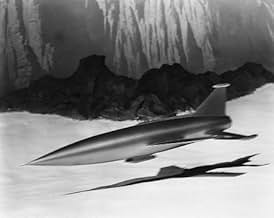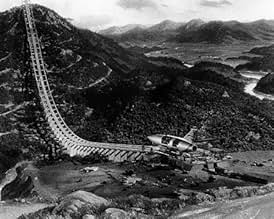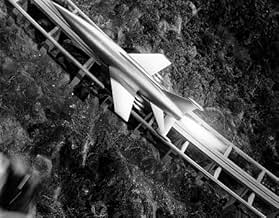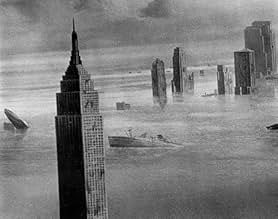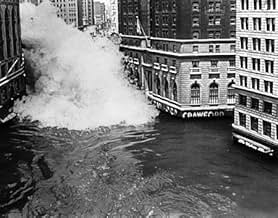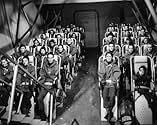As a new star and planet hurtle toward a doomed Earth, a small group of survivalists frantically work to complete the rocket which will take them to their new home.As a new star and planet hurtle toward a doomed Earth, a small group of survivalists frantically work to complete the rocket which will take them to their new home.As a new star and planet hurtle toward a doomed Earth, a small group of survivalists frantically work to complete the rocket which will take them to their new home.
- Director
- Writers
- Stars
- Won 1 Oscar
- 2 wins & 1 nomination total
Peter Hansen
- Dr. Tony Drake
- (as Peter Hanson)
Rachel Ames
- Julie Cummings
- (as Judith Ames)
Kirk Alyn
- Rioter Bringing Guns
- (uncredited)
Gertrude Astor
- Traveler
- (uncredited)
Mary Bayless
- Club Patron
- (uncredited)
Nina Borget
- Translator
- (uncredited)
Steve Carruthers
- Delegate
- (uncredited)
Robert Chapman
- Student
- (uncredited)
Gene Collins
- Newsdealer
- (uncredited)
James Congdon
- Eddie Garson
- (uncredited)
- Director
- Writers
- All cast & crew
- Production, box office & more at IMDbPro
Featured reviews
When I was younger, this was one science fiction film that definitely made an impression on me. This was one of those where I actually was scared that one day my world would come to an end. However, as I got older I realized that this was just a movie, but still it is one of the best genre films of its era. Sure, it has its flaws (especially the painted background at the end), but still it is a film that was a product of its time and it will always be one of my favorites.
First, this is a nice-looking film with a good DVD transfer. Seeing an early '50s sci-fi film Technicolor is nice.
Also, having just watched - I'm not kidding - "Plan 9 From Outer Space" and "Invaders From Mars," this George Pal film looked like multi-million dollar Oscar winner in comparison. Except for the ending scene, the special-effects were passable, the acting was good and the dialog pretty realistic. The story plausible? Of course not, but what they did know of space travel in 1951? Hell, we didn't send a man on the moon until almost 20 years after this movie. No, this is not one of those popcorn flicks that "is so bad, it's good" or just plaint stink. No, this movie is just good......period....even today, almost 57 years later!.
This was a no-nonsense survival story without an overdone corny romance, no stupid or obnoxious kids nor goofy-looking adults. It had a solid reverence for God and to science at the same time, a realistic portrayal of people under stress and how they would react knowing their world was coming to end. For a mostly talky film, it moved fast with few, if any lulls.
John Hoyt, who plays the wheelchair-bound millionaire "Sydney Stanton," may not be a "name" actor but he's very good. Check his resume: it's awesome. The man was in about every good television show for decades. The man could act. So did the rest of this cast.
Overall, this "modern" Noah's Ark story was a good one, and far, far better than your normal sci-fi flicks from the time period. Well done!
Also, having just watched - I'm not kidding - "Plan 9 From Outer Space" and "Invaders From Mars," this George Pal film looked like multi-million dollar Oscar winner in comparison. Except for the ending scene, the special-effects were passable, the acting was good and the dialog pretty realistic. The story plausible? Of course not, but what they did know of space travel in 1951? Hell, we didn't send a man on the moon until almost 20 years after this movie. No, this is not one of those popcorn flicks that "is so bad, it's good" or just plaint stink. No, this movie is just good......period....even today, almost 57 years later!.
This was a no-nonsense survival story without an overdone corny romance, no stupid or obnoxious kids nor goofy-looking adults. It had a solid reverence for God and to science at the same time, a realistic portrayal of people under stress and how they would react knowing their world was coming to end. For a mostly talky film, it moved fast with few, if any lulls.
John Hoyt, who plays the wheelchair-bound millionaire "Sydney Stanton," may not be a "name" actor but he's very good. Check his resume: it's awesome. The man was in about every good television show for decades. The man could act. So did the rest of this cast.
Overall, this "modern" Noah's Ark story was a good one, and far, far better than your normal sci-fi flicks from the time period. Well done!
Loved this movie!......remember, this was 1951 so don't expect the computer generated special effects that we enjoy today. The roller coaster rocket ship take-off is like something from a comic book but, again, remember when this was made.....who knew about rockets to outer space? Richard Derr, whoever he was, is OK in the lead but seems a little bit laid back for someone who knows the world is going to end with a bang. In fact, most of the cast, seems rather off-hand until the very end when the chips are down and decisions are being made as to who lives and who gets to stay for the big one. There are a lot of familar faces (except for Derr) in this movie although they are mostly second leads and not "stars". Look for some walk-ons from actors on their way down and on their way up......John Ridgely who was a staple in WWII films, Kirk Alyn, Superman from the old serials, and Stuart Whitman who would go on to play some decent roles in the 60's and 70's. This film may not be "Independence Day", but it is the best of the early doomsday/futuristic movies of the time.
...I remember rushing in from playing football in the street to watch the world ending on our little b&W TV. I remember thinking what I would do in that situation? I had nightmares for days after especially about the image of Bellus swallowing the world. Wasn't Bellus a star? Coz Zyra, the planet, sailed past days before causing earthquakes and loads of nasty stuff. It doesn't matter about effects (1951? This was top notch!) but what does matter is that you cared about the characters; the desolation when one engineer gives up his seat because his girl friend wasn't lucky enough to draw a place and was willing to meet his fate with his loved one by his side... THAT'S romance! And that ski-jump take off... and that rocket!!!! It's definitely one of the best of it's genre and everyone else is right.. the recent batch of similar films aren't a patch on this. Remember characterization, chaps! Enjoy...
George Pal, Hungarian born Puppetoon creator and fantasy legend made several great science fiction space movies. Adaptations of popular books in the 50's included former German rocket scientist Willy Ley's "Conquest Of Space" using designs and ideas illustrated by space artist Chestley Bonestell, who's work is seen in almost all of Pal's space films in one way or another, considered cutting edge for the time. His others included H.G.Wells classic "War Of The Worlds", Robert Heinlein's "Destination Moon" and the Edwin Balmer & Philip Wylie 1932 novel "When World's Collide".
The results still stand as seminal classics of science fiction filmwork, often copied, referenced and paid homage in one way or another. Although perhaps dated by the computer generated, digitally enhanced SFX of today's so-called masterpieces, these films still stand out as the major influences which helped shape our dream, visions and often spoke to our deepest fears, such as the end of the world.
From the inverted ski jump launch system (used today on aircraft carriers), to expendable booster rockets (a Space Shuttle standard), the Ark spaceship spawned the imagination of many filmakers, including some who reused the model for other films such as "Flight To Mars" and "The Queen Of Outer Space". The movie still stands as a milestone as the first science fiction disaster movie.
Once again, Leith Stevens' musical score enriches the experience, as it did for Pal's previous space adventure, "Destination Moon". The film's special effects won it the Oscar in 1951. All this, and in the rich tones of Technicolor that shall never been seen in a first run movie theater again. Thank you Lord for revival houses that still manage to seek out old time prints for festivals (the Alamo Drafthouse in Austin, Texas comes to mind).
There still remains a bit of controversy, though, about the film's ending. A wide, panoramic Bonestell matte painting is seen from the hatch of the newly arrived Ark. In the image can be seen two clearly pyramidal mountains in perfect proportions, as if artificial, as well as the base of what appears to be a building constructed by an alien intelligence. Although the actors don't react to this (the matte effect added in post production), the artwork hints at the planet Zyra as being inhabited (In the novel, the planet is known as Bronson Beta, and is indeed found to be once inhabited, and is explored further in the sequel "After Worlds Collide").
In the 1970s, producers Richard Zanuck and David Brown attempted to do a remake, which eventually mutated into the 1998 film, "Deep Impact". As in "When Worlds Collide", the human interaction was as important as the science fiction elements.
The results still stand as seminal classics of science fiction filmwork, often copied, referenced and paid homage in one way or another. Although perhaps dated by the computer generated, digitally enhanced SFX of today's so-called masterpieces, these films still stand out as the major influences which helped shape our dream, visions and often spoke to our deepest fears, such as the end of the world.
From the inverted ski jump launch system (used today on aircraft carriers), to expendable booster rockets (a Space Shuttle standard), the Ark spaceship spawned the imagination of many filmakers, including some who reused the model for other films such as "Flight To Mars" and "The Queen Of Outer Space". The movie still stands as a milestone as the first science fiction disaster movie.
Once again, Leith Stevens' musical score enriches the experience, as it did for Pal's previous space adventure, "Destination Moon". The film's special effects won it the Oscar in 1951. All this, and in the rich tones of Technicolor that shall never been seen in a first run movie theater again. Thank you Lord for revival houses that still manage to seek out old time prints for festivals (the Alamo Drafthouse in Austin, Texas comes to mind).
There still remains a bit of controversy, though, about the film's ending. A wide, panoramic Bonestell matte painting is seen from the hatch of the newly arrived Ark. In the image can be seen two clearly pyramidal mountains in perfect proportions, as if artificial, as well as the base of what appears to be a building constructed by an alien intelligence. Although the actors don't react to this (the matte effect added in post production), the artwork hints at the planet Zyra as being inhabited (In the novel, the planet is known as Bronson Beta, and is indeed found to be once inhabited, and is explored further in the sequel "After Worlds Collide").
In the 1970s, producers Richard Zanuck and David Brown attempted to do a remake, which eventually mutated into the 1998 film, "Deep Impact". As in "When Worlds Collide", the human interaction was as important as the science fiction elements.
Did you know
- TriviaScreenwriter Bruce Joel Rubin saw this film as a ten-year-old, and has cited it as "the beginning of the emergence of philosophy" in his life. In The Dialogue: An Interview with Screenwriter Bruce Joel Rubin (2007), he explains that right after he and a boyhood friend saw the film, they spent hours discussing the end of the world. Rubin mentions this memory while explaining that Steven Spielberg approached him to do the screenplay for a remake of "When Worlds Collide," and that it eventually evolved into Deep Impact (1998), with Rubin credited as one of its two writers.
- GoofsThroughout the film, Bellus is referred to as a star; this is presumably how life is able to be sustained on Zyra. However, if this was the case, Earth would have been destroyed from the heat long before Bellus collided with it, even if it was a small brown-dwarf star. Also, departure should have been at least 17 days earlier, before descending deep into Bellus' gravity well and needing far more fuel. This part of the plot, and the time to build the ship, could have been resolved by sticking to the novel's pair of planets and a longer time frame - Zyra and Bellus both passing by with Bellus, a gas giant planet, ripping up Earth's surface, then returning months later for Bellus' direct collision with Earth, as Zyra enters orbit around the sun.
- Quotes
Sydney Stanton: Your salvation doesn't interest me; mine does.
- ConnectionsEdited from Spawn of the North (1938)
Details
- Release date
- Country of origin
- Languages
- Also known as
- Cuando los mundos chocan
- Filming locations
- Calabasas, California, USA(Rocket Ship Campsite)
- Production company
- See more company credits at IMDbPro
Box office
- Budget
- $936,000 (estimated)
- Runtime1 hour 23 minutes
- Aspect ratio
- 1.37 : 1
Contribute to this page
Suggest an edit or add missing content





